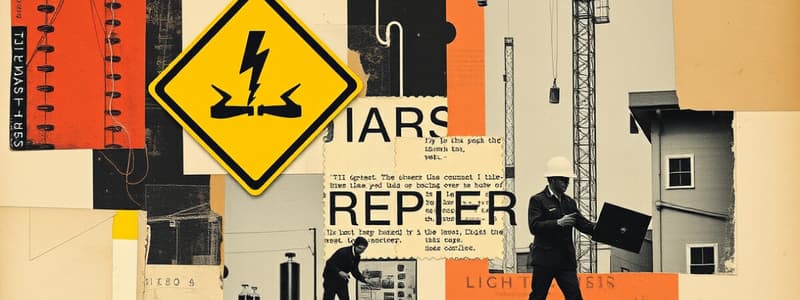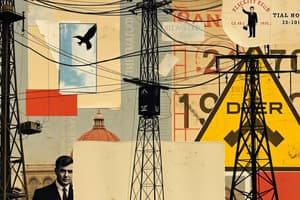Podcast
Questions and Answers
What is the primary cause of most electrical injuries in construction?
What is the primary cause of most electrical injuries in construction?
- Improper training on safety standards
- Using outdated tools
- Faulty safety equipment
- Working near overhead power lines (correct)
What safety measure should be taken when working with tools near high-voltage lines?
What safety measure should be taken when working with tools near high-voltage lines?
- Use metal ladders for support
- Maintain a minimum distance of 10 feet (correct)
- Maintain a distance of at least 5 feet
- Ensure tools are unplugged before inspection
What is a Ground Fault Circuit Interrupter (GFCI) designed to do?
What is a Ground Fault Circuit Interrupter (GFCI) designed to do?
- Enhance voltage in electrical circuits
- Allow for more current flow in extension cords
- Prevent electrical shock during wet conditions
- Cut off power quickly in case of ground faults (correct)
What is the leading cause of fires on construction sites related to electricity?
What is the leading cause of fires on construction sites related to electricity?
Which type of electrical hazard is described as a violent explosion of electrical energy?
Which type of electrical hazard is described as a violent explosion of electrical energy?
What is an important safe work practice when using electrical tools?
What is an important safe work practice when using electrical tools?
Which of the following is NOT a common source of electrical exposure?
Which of the following is NOT a common source of electrical exposure?
Lockout/Tagout procedures are essential for what purpose?
Lockout/Tagout procedures are essential for what purpose?
Flashcards are hidden until you start studying
Study Notes
Electrical Hazards in Construction
- Electricity powers tools, lights, and equipment on construction sites but poses significant risks including shocks, burns, and electrocution.
- Over 100 construction workers die from electrocution annually; it ranks as the 4th leading cause of death in the field.
- OSHA's regulations focus on preventing electrical injuries through established safety standards and mandatory employee training on electrical hazards.
Types of Electrical Hazards
- Burns: Result from electric current exposure, arc flashes, or heated surfaces.
- Electrocution: Fatal exposure to lethal electricity.
- Shock: Occurs when electric current flows through the body.
- Arc Flash: Violent explosion of electrical energy that can reach temperatures of 35,000°F.
- Fires: Caused by faulty cords, wiring, or overloaded switches.
- Explosions: Triggered by sparks igniting flammable vapors or dust.
Common Sources of Exposure
- Overhead power lines and contact with energized components are major risks.
- Misuse of extension cords and the use of faulty tools can lead to serious injuries.
Safety Standards for Overhead Power Lines
- High-voltage lines can carry between 120 to 750,000 volts; significant caution required when working near them.
- Maintain a minimum distance of 10 feet from power lines; use non-conductive ladders (e.g., fiberglass).
- Notify utility companies to de-energize or cover lines for safety.
Safe Work Practices with Tools and Equipment
- Inspect electrical tools for any signs of damage (e.g., frayed cords, rust, or corrosion) before use.
- Follow the manufacturer's operating instructions and never carry tools by their cords.
- Use only heavy-duty grounded extension cords with three-prong plugs; homemade cords are unsafe.
Ground Fault Protection
- Ground faults occur when electricity escapes the circuit; can cause severe injuries.
- Employers must implement either an Assured Equipment Grounding Conductor Program (AEGCP) or use Ground Fault Circuit Interrupters (GFCIs) to prevent electrocution.
- GFCIs cut off power within fractions of a second if a ground fault is detected.
Lockout/Tagout Procedures
- Essential for safely maintaining or repairing electrically powered equipment.
- Identify energy sources, inform affected employees, and securely lock out power sources to prevent accidental re-energization.
- Use dedicated locks for lockout/tagout, and ensure testing by a qualified person to verify de-energization.
Conclusion
- Understanding and following OSHA's electrical safety standards significantly reduces risks associated with electricity on job sites.
- Awareness of hazards, proper training, and adherence to safety protocols ensure a safer work environment, enabling workers to return home safely.
Electrical Hazards in Construction
- Electricity is essential for operating tools and equipment at construction sites but can lead to serious injuries like shocks, burns, and electrocution.
- Electrocution is the fourth leading cause of death in construction, with over 100 fatalities annually in the industry.
- OSHA mandates safety standards and training to reduce electrical hazard-related injuries among workers.
Types of Electrical Hazards
- Burns: Result from direct electric current, arc flashes, or overheated surfaces.
- Electrocution: Fatal outcome caused by exposure to high-voltage electricity.
- Shock: Occurs when electric current passes through the body's tissues.
- Arc Flash: A dangerous event with explosive electrical energy temperatures reaching up to 35,000°F.
- Fires: Could be sparked by defective wiring, overloaded circuits, or faulty cords.
- Explosions: Can happen when sparks ignite flammable materials in the environment.
Common Sources of Exposure
- Overhead power lines pose a significant contact risk and can also involve energized equipment.
- Improper use of extension cords and malfunctioning tools increase the likelihood of injuries.
Safety Standards for Overhead Power Lines
- High-voltage power lines can range from 120 volts to 750,000 volts, necessitating careful precautions.
- Workers should maintain a minimum distance of 10 feet from power lines and utilize non-conductive materials like fiberglass ladders.
- Prior notification to utility companies is essential for de-energization or insulation of lines during work.
Safe Work Practices with Tools and Equipment
- Electrical tools should be thoroughly inspected for damage, such as frayed cords or signs of deterioration, prior to their use.
- It is crucial to follow the manufacturer’s instructions for operation and to avoid handling tools by their cords.
- Only use heavy-duty extension cords with grounded, three-prong plugs; homemade cords are considered unsafe.
Ground Fault Protection
- Ground faults happen when electrical current leaks from its intended circuit, posing electrocution risks.
- Employers are required to implement an Assured Equipment Grounding Conductor Program (AEGCP) or to utilize Ground Fault Circuit Interrupters (GFCIs) for employee safety.
- GFCIs automatically cut off power rapidly when detecting any ground faults.
Lockout/Tagout Procedures
- These procedures are vital for the safe maintenance and repair of electrically powered machinery.
- Workers must identify energy sources and inform all affected personnel before securely locking out power to avoid unintentional reactivation.
- Dedicated locks should be used for lockout/tagout processes, and a qualified person must confirm that equipment is truly de-energized.
Conclusion
- Adherence to OSHA electrical safety guidelines greatly mitigates workplace electrical hazards.
- Comprehension of potential dangers, thorough training, and strict compliance with established protocols contribute to a safer construction environment, enabling workers to return home well.
Studying That Suits You
Use AI to generate personalized quizzes and flashcards to suit your learning preferences.




